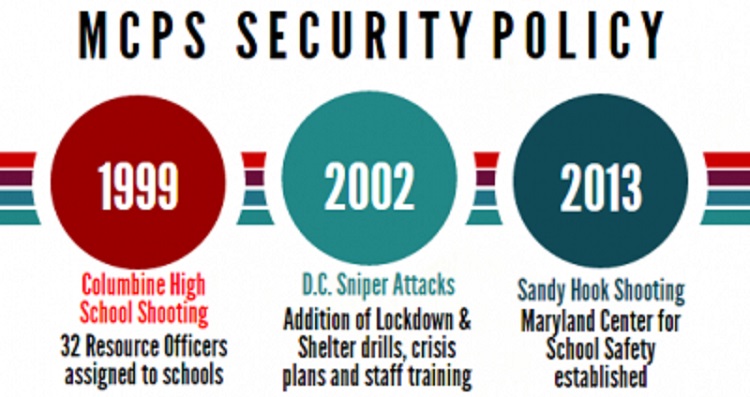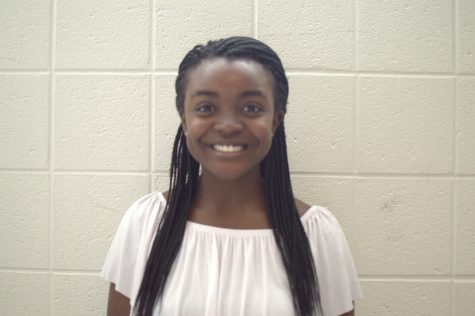New threats demand upgraded policies: analyzing the evolution of school safety and security
December 19, 2016
A butcher knife-wielding student recently drove a car through a crowded sidewalk, leapt out and viciously stabbed pedestrians in his path. This horrific attack at Ohio State University that left 11 students and staff injured Nov. 28 echoes an all too familiar narrative of the perpetual threats that bring peril to American schools.
This school year, MCPS schools have endured a variety of precarious situations that put student safety at risk, including targeted clown-related threats and bomb threats to Montgomery Blair High School and Magruder High School. By comparison, the county did not report any bomb threats in its 2014-2015 school safety and security publication.
When student safety is threatened, communities look to school security for protection and guidance. As threats to schools within the county and nationwide evolve, the systems and policies in place to protect students have been forced to adapt to changing times.
Uncovering the Need for Reform
In 1999, two students at Columbine High School in Colorado killed 13 people including students and teachers in a shooting spree that shocked the nation. Not only did the massacre ignite a national debate on gun control, but the relatively unprecedented incident also jumpstarted the need for schools to analyze and improve their safety policies.
“We needed to start planning for things we never really knew we had to,” said Doug Steel, MCPS Supervisor of School Safety and Security.
Before Columbine, school security policies for active shooter situations centered around securing the area and waiting on a SWAT team. In the aftermath of the tragedy, policies began to favor swift action from well-trained first responders, largely law enforcement officers.
It was very confusing because at that time people didn’t have their phones on them like they do today.
— English teacher Ashley HoughtonIn MCPS, the Educational Facilities Officers Program, established September 2002, arranged for 32 School Resource Officers (SROs) to be assigned to all high schools and two middle schools between 2003 and 2010. SROs are armed law enforcement officers who receive special training in emergency preparedness and crisis management.
Before the program could be initiated, the October 2002 D.C. sniper attacks compelled MCPS to undergo yet another comprehensive reformation. By the time the perpetrators were caught, they had killed 10 people in the metropolitan area and critically injured three more, with six of the homicides carried out in Montgomery County.
The seemingly random nature of the shootings put residents on edge. A letter from one of the shooters even declared that children were no longer safe anywhere. English teacher Ashley Houghton was in her first year teaching when news that a shooter was a mile away from her school sent all county schools into a three-hour lockdown.
“It was very confusing because at that time people didn’t have their phones on them like they do today, so we were kind of in the dark about what was happening,” Houghton said. “Kids were more afraid because they didn’t understand why they weren’t allowed to leave the room. There was less transparency at that time.”
The attacks revealed an imminent need for more concrete emergency preparedness protocols, which the county met by developing crisis plans and training staff to handle emergencies, both documented and hypothetical, equipping them with the skills needed to counter violence on school grounds.
The National School Safety and Security Services compiled and published a list of risk reduction measures and relevant emergency plans, including relocating exposed bus stops, reviewing evacuation procedures and staggering dismissal times. MCPS mandated more aptly named scenario-based drills in 2011, known as shelter and lockdown, before the state of Maryland did in 2013, Steel said.
The 2013 tragic shooting at Sandy Hook Elementary in Newtown, CT prompted Maryland lawmakers to seek a more cohesive solution for the state.The killing spree claimed the lives of 26 first-graders and teachers in a school environment meant to serve as a safe space.
Maryland’s state legislature established the Maryland Center for School Safety in 2013 to coordinate efforts among school systems, law enforcement, private security organizations and legislative and judicial entities to optimize student safety. According to its annual report, the center holds a weekly conference call to “provide timely and accurate information regarding potential terrorist threats and other school safety concerns.”
With former MCPS director of safety and security Edward Clarke serving as Executive Director, the center provides information and training in violence prevention and conducts comprehensive research on issues pertaining to school safety.
“If a state doesn’t have a resource that gathers information and provides training, it trickles down to the students,” Steel said.
Modern School Safety and Security
Today, the MCPS Department of Safety and Security employs over 200 security personnel within schools intended to serve as mentors to students, not just as security guards.
“When students trust you, they can come talk to you, and they can talk to you about anything, whether it’s something personal that’s going on with them, or if it’s something they saw going on in the school that they wanted to report, or if a friend is having issues,” Whitman Security Team Leader Cherisse Milliner said.
The hope is that better communication with students will contribute to maintaining a safe environment and limiting potential dangers.
“By building those relationships, you are hopefully going to reduce the number of those kinds of situations,” Steel said.
Students and teachers also acknowledged that effective communication contributes to their trust in the school’s security system.
“The faster the communication can happen, then the more ready we’re able to act,” Houghton said.
When clowns sent threats to several county schools this year, MCPS quickly took to social media to supply the facts of the incident to media outlets and the community.
“Communication is most effective when someone is verifying accurate information before releasing it out there,” Steel said.
We have more than just our eyes helping. We have eyes from the community now.
— Security Team Leader Cherisse MillinerSafety and Security at Whitman
At Whitman, the security system currently uses over 100 cameras with 24-hour operation throughout the school that staff and MCPS central security offices can access in an incident. SROs are now equipped with body cameras, a policy that began in 2015. Despite this, some students still expressed concerns over whether security and staff are equipped to handle an emergency situation.
“We do have the open lunch,” sophomore Lucille Filyaw said. “They don’t even pay attention to who walks in the school, so anyone could walk in.”
Sophomore Elise Mytelka agreed that the unpredictability of events made her anxious.
“They don’t know when it’s going to happen or if it’s going to happen, so it’s hard to prepare for that,” Mytelka said. “It makes me really stressed out because I’m always like, ‘What if I’m next?’”
In the event of an emergency, it becomes crucial that students are not put at risk by an outdated system. This school year, Whitman security added access control pads that require key cards for entry to three locations outside of the school. Additionally, the front door is no longer left unlocked and visitors must be buzzed in by the main office.
“Without these things, it would be impossible for us to be as productive as we are here,” Milliner said.
As threats to schools have come to the forefront of society, the school community has developed a heightened awareness and adopted a key role in helping school security identify and stop threats.
“We have more than just our eyes helping,” Milliner said. “We have eyes from the community now.”









